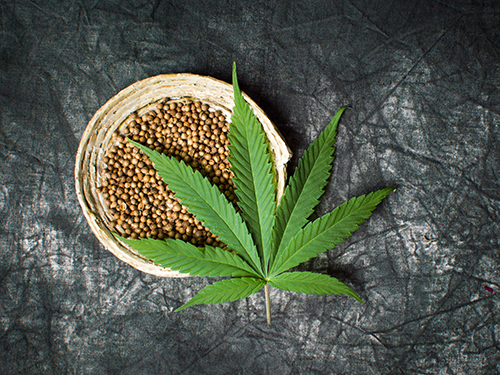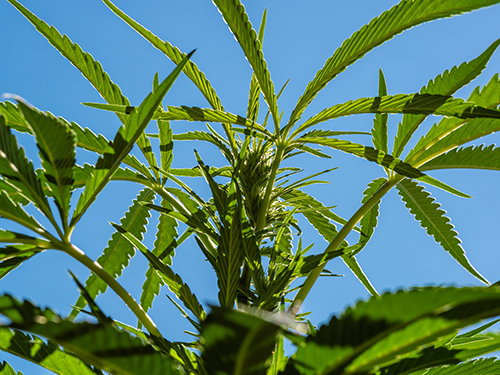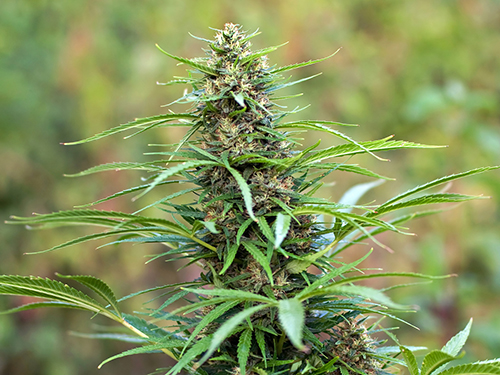
Fact Sheet FS1312
Hemp was once a common agricultural crop throughout the United States. Prior to the passage of the 1937 Marijuana Act, hemp was grown primarily as a fiber crop in the United States. The passage of the 2014 Farm Bill established a renewed interest in producing industrial hemp. Much of the interest has focused on producing hemp for cannabidiol (CBD). However, it should be recognized that there is still potential to produce hemp as a fiber or grain crop.
If contemplating hemp production, it is important to keep in mind that there have been very few U.S.-based agronomic research studies on industrial hemp since the early 20th century. Information from previous research is important and useful but may not always be completely applicable for modern production systems. Industrial hemp is an untested crop in New Jersey. Research is needed to provide data on planting, management, fertility, harvesting, and processing specific to New Jersey. As a result, production information gaps may be encountered in the short term.
It is important to note there are differences in production systems based on the end use of the hemp. This fact sheet will provide information for producers investigating growing and marketing industrial hemp. Industrial hemp grown for grain or fiber production more closely matches existing grain and forage cropping systems than that of hemp grown for CBD. Because we currently have no New Jersey-specific research results or production experience, the information provided will be based on information from surrounding states and the regions that have participated in industrial hemp pilot programs. The reader should be aware the information is being provided as guidance and will be updated with New Jersey-specific information once available.
Market Research
Although industrial hemp production may provide an opportunity for New Jersey, it is crucial that producers carefully examine the market and accessibility of market channels as part of their overall operation. As is the case with any emerging agricultural product, limited data exists to quantify the economic feasibility of industrial hemp production in New Jersey.
It is extremely important to know how to market hemp and where to sell it. One of the most common reasons for not succeeding with an alternative or niche crop is from lack of research as to where to sell the crop and its potential value. It is recommended to first determine if there are processors or buyers in close proximity. Producers growing industrial hemp should also determine if there is any requirement to contract with a buyer in order to sell the crop. Keep in mind that certain contracts specify varieties to be grown and may also require the crop to be grown using specific production practices.
Legality and Permits
The New Jersey Department of Agriculture is tasked with developing regulations for producing industrial hemp in the state. These regulations will include creating requirements for licensing of growers, prescribing hemp testing procedures to ensure compliance with federal law, creating a fee structure for the administration of the program, and certifying germinating seeds and hemp cultivars if necessary. Information about the application process to grow industrial hemp in New Jersey will only be available once regulations are finalized as required under the 2018 Farm Bill. Until New Jersey State Hemp Regulations are finalized and the permit process is in place, it is illegal to produce industrial hemp in the state.
THC (tetrahydrocannabinol) Requirement
The 2018 Farm Bill recently signed by President Trump removes industrial hemp and its derivatives containing less than 0.3% THC from the Controlled Substances Act, thus legalizing the cultivation of industrial hemp and the hemp derivative CBD oil. Federal and state law requires that the concentration of THC must be less than 0.3% in industrial hemp. By definition, industrial hemp is low (less than 0.3%) in tetrahydrocannabinol (THC), the cannabis plant’s primary psychoactive chemical. When selecting varieties for production, growers should look for varieties certified as having <0.3% THC. Producers should be aware that THC spikes have been reported across the country when producing industrial hemp, which have required the crops to be destroyed rather than harvested.
Background
Cannabis sativa is a summer annual plant. It is a very photoperiod sensitive crop. As a result, flowering is initiated according to day length (photoperiod) not physiological maturity. Most hemp varieties initiate flower development when day length is less than approximately 12 hours. Hemp is mostly dioecious (male and female flowers occur on separate plants). Therefore, there are both male plants and female plants. Although some monoecious varieties exist, most cultivated hemp is currently dioecious. There are breeding programs to increase the availability of monoecious varieties. Different plant parts are harvested from hemp for specific purposes. Depending on the harvestable plant part of interest, (i.e. fiber, grain, or cannabinoids) male plants and pollen might be required for production, or completely unnecessary, or even excluded from production through management.
The grain (seed) of hemp can be used in numerous ways. As a dietary supplement it is very rich in omega-3 and omega-6 fatty acids compared to other potential sources. It is relatively high in oil content. Hemp grain processors produce a wide array of products including toasted hemp seed, hemp seed oil, hemp flour, and even hemp coffee. It is used as bird feed and livestock feed, much the same as soybean hulls are used today.
Uses of hemp fiber have evolved greatly since the late 19th and early 20th centuries where it was used primarily for rope and cloth. Today hemp fiber can be used in many products ranging from construction materials, concrete additives, and many other materials.
Cannabidiol (CBD) oil is extracted from resins produced largely in female flowers. CBD is used as a health supplement with purported health benefits including pain relief, inflammation, and others. Much of the anticipated growth in the industrial hemp industry is expected to be related to production of CBD and related value-added products. CBD from hemp is thought to have numerous applications as a nutraceutical, pharmaceutical, or dietary supplement.
Types of Hemp
Grain
Grain varieties are selected for food and nutritional applications. Grain varieties have high protein, fatty acid, and seed fiber content and usually have lower CBD content. Grain varieties are often shorter in height, reducing the amount of biomass that passes through the combine and reducing wrapping in the combine. Grain hemp seed is thin-walled and can be fragile. The fragile seeds must be handled with care when harvested and transported to market.
Fiber
Fiber varieties of hemp produce long fibers and increased biomass. Fiber hemp varieties are generally taller and favor vegetative growth over seed production. These types of hemp have a wide range of uses, including textiles, building materials, pulp/paper, and more. Ideally, producers of hemp fiber will have access to processing facilities nearby due to the bulk of the product and cost of transport.
Dual Use (Hybrid)
Dual Use varieties of hemp produce both fiber and seed, but not to the yield or quality of single purpose cultivars.
Cannabinoid (CBD)
CBD varieties are currently the most lucrative for agricultural production and marketing. These varieties can present regulatory challenges when attempting to produce the highest yield of CBD, while keeping the THC within allowable levels. High CBD varieties are generally grown utilizing only female plants, as the combination of male and female plants leads to increased seed production and decreased cannabinoid yields.
Variety selection will be key to successful production of all hemp types for many reasons; one of the most important varietal traits is days to maturity (latitudinal adaptation). For grain growers, this is similar to how soybean varieties are selected according to maturity group. There are several considerations when selecting the correct variety for production. For example, varieties bred primarily for grain production could have significantly different maturity dates relative to each other, and therefore would have very different establishment dates for maximum yields and a crop that is harvestable with standard equipment. Producers growing hemp for CBD production or for dual-use production systems will likely require different varieties to maximize yields and other characteristics.
As we begin to have more experience with hemp production, we are learning that varieties are regionally-specific. Farmers looking to enter the industrial hemp market for the first time will need to understand varietal options that are available and carefully determine which hemp variety is most suitable to their production and marketing strategies.
Field Selection
Hemp grows best on a loose, well-aerated loam soil, with high fertility, abundant organic matter (> 2%), and a pH of 6.0–7.5. Well-drained soils are best, as poorly-drained, heavy textured soils, or poorly structured soils often result in stand establishment failures. Reports indicate seedlings and young plants are prone to damping-off, resulting in poor stands. Sandy soils can produce hemp with adequate irrigation and fertilization, but these additional costs will need to be evaluated with respect to production economics.
Fertility
Fertilizer requirements are best determined by a soil test. Penn State has developed fertilizer recommendations for hemp. There is limited experience with hemp production in our region. Recommendations are based on the most current information available. In a soil with optimum levels of phosphorus (P) and potassium (K), nutrient recommendations for a 1,500 pound/acre grain yield potential would be 150 pounds of nitrogen (N), 30 pounds of phosphate (P2O5), and 20 pounds of potash (K2O). Fertility recommendations for hemp grown for fiber at optimum P and K soil test levels would be 150 pounds of N, 20 pounds of P2O5, and 20 pounds of K2O per acre.
Planting
Hemp can be planted in rows, like corn, or with a grain drill, like a small grain. The seed is fragile and can be damaged during planting. No herbicides or other pesticides are currently labeled for hemp in the US. Potential production strategies to reduce weed competition include narrow row planting, high planting density, and planting tall varieties. If planted in wider rows, mechanical cultivation may be required when the crop is young to reduce weed competition.
There have been reports that hemp seed germination is impacted by a lack of soil moisture content at planting. This could lead to uneven stands and result in increased weed pressure. Hemp should be seeded in soils with sufficient moisture to promote rapid germination. Rapid germination and stand establishment are essential to out-compete weeds. There are many reports that seedlings can be weak and struggle to become established if planted in drier than optimal soils. However, once successfully established, plants are very hardy.
Earlier maturing varieties may be preferred for grain production, and in some instances, they may be desired for both grain and fiber harvest. Shorter varieties are generally chosen for grain production as this reduces the amount of plant material running through the combine and reduces plant fibers wrapping in the combine.
Recommendations for planting rates vary depending on end use of the crop. Planting rate recommendations are most always provided as pounds of pure live seed (PLS) per acre. Pure live seed (PLS) is the seed in a container that will likely produce a viable plant when planted. A review of planting rate recommendations for hemp grain production reveals recommendations from as low as 20 to as high as 40 pounds per acre. The majority of recommendations encountered ranged from 25–35 pounds per acre for grain. Planting rates for fiber production range from 35–60 pounds per acre and are generally planted in higher densities to promote vegetative growth and bast fiber development.
Good seed-to-soil contact is required to achieve the best germination rate of industrial hemp seed. A firm, level, and relatively fine seedbed (similar to seeding forages) should be prepared before planting. The range in recommendations for planting depth is for ½ to 1 inch deep, with the majority of planting recommendations falling into the ½ to ¾ inch depth.
Insects and Diseases
There is potential for disease and insect pest problems, but information and recommendations are lacking for New Jersey and other states. Like most plants, hemp is prone to insects and pathogens, causing damage and diseases. As the acreage of industrial hemp increases, the number of insect pests and pathogens will tend to increase as well.
Insect pests that have been reported to cause damage across North America include the European corn borer, armyworm, and grasshoppers. Plant diseases including gray mold (Botrytis cinerea) and white mold (Sclerotinia sclerotiorum) have been reported to infect and impact industrial hemp production. No pesticide materials are currently registered for use on hemp, therefore more research is needed in this area to minimize these potential challenges.
Harvest
For seed production, hemp is harvested when seeds begin to shatter. The plants will still be green. At this time about 70 percent of the seeds will be ripe and the seed moisture is often about 22–30 percent. If harvesting is delayed, then grain losses can increase from shattering, bird damage, and lower grain quality. There is also a greater problem with the fiber in the stalks wrapping in the combine. Avoiding taller varieties can help reduce the amount of material going through the combine. Grain combines can be used for grain harvest and some recommendations have suggested settings similar to those used for grain sorghum. Hemp grain is thin-walled and fragile, requiring care in harvest, storage, and transport. Grain should be dried immediately after harvest to less than 10% moisture.
Harvest for fiber production in many ways is similar to harvesting forages. Forage harvesting and handling equipment have been reported to perform well without major modifications. One common caution that can be found with regard to fiber production is that any machinery with rotation, pickup heads, or rolling bearings can easily lead to hemp wrapping to the point where machinery can become plugged. Hemp cutting can be accomplished with a disc bine, a disc mower, or a straight sickle mower. Specialized equipment for cutting hemp for fiber is available from some overseas manufacturers. There are reports that swathers and haybines do not work well, especially with very tall crops, as there is a tendency for long stems to wrap on the reel.
Once cut for fiber, hemp must undergo retting. Retting is a process involving the use of moisture and microbes to break down the bonds holding the hemp stem together, enabling easier separation of fibers. Field retting is most commonly used where the hemp is left in the field to partially decompose naturally from dew, molds, and bacteria. This process can take 4–6 weeks depending on the weather and must be closely monitored. After retting, the stalks are dried to a moisture content of less than 15% and baled. A baler may be used to bale the hemp stalks, at which point the stalks are ready for storage.
There is no established technique for CBD harvest on a large-scale acreage. Research is needed to understand the best way to harvest CDB for large-acreage production. Currently most CBD production is on small-acre plots or in greenhouses. Harvest for CBD production can be very labor intensive. Harvesting hemp at the proper stage is critical for CBD production. The presence of molds and mildews will lower the value of hemp floral biomass. Current reports show the vast majority of hemp growers producing for the CBD market rely on manual labor to cut the stalks. This is accomplished most often with a machete. Once hemp is harvested, growers should immediately move the floral biomass into the drying facility. Slow drying with high airflow will cure the hemp flowers and produce a higher quality end product.
Additional Resources
- University of Kentucky Industrial Hemp Agronomic Research. hemp.ca.uky.edu
- The Ontario Ministry of Agriculture, Food and Rural Affairs’ hemp production fact sheet. www.omafra.gov.on.ca/english/crops/facts/00-067.htm
- Cornell Hemp Resources. hemp.cals.cornell.edu/hemp-resources/hemp-growing-info
- Penn State Industrial Hemp Production. extension.psu.edu/industrial-hemp-production
References
- Williams, D.W. and R. Mundel. 2018. An Introduction to Industrial Hemp and Hemp Agronomy. Cooperative Extension Service Publication ID-250. College of Agriculture, Food and Environment, University of Kentucky. www2.ca.uky.edu/agcomm/pubs/ID/ID250/ID250.pdf
- Hemp as an Agricultural Commodity, Congressional Research Service, June 2018. fas.org/sgp/crs/misc/RL32725.pdf
- Cherney, J.H.; Small, E. Industrial Hemp in North America: Production, Politics and Potential. Agronomy 2016, 6, 58. DOI
Photo credits: iStockphoto.com
November 2019
Copyright © 2024 Rutgers, The State University of New Jersey. All rights reserved.
For more information: njaes.rutgers.edu.
Cooperating Agencies: Rutgers, The State University of New Jersey, U.S. Department of Agriculture, and Boards of County Commissioners. Rutgers Cooperative Extension, a unit of the Rutgers New Jersey Agricultural Experiment Station, is an equal opportunity program provider and employer.



